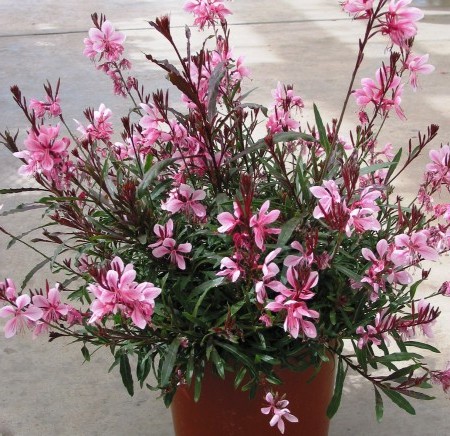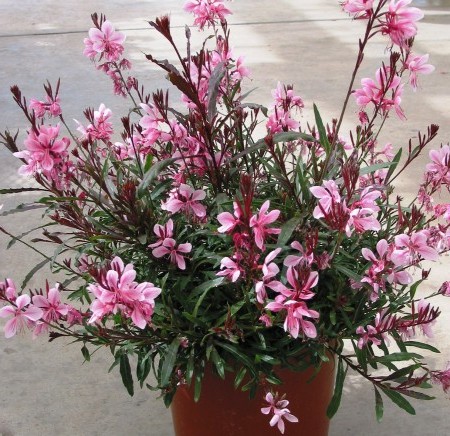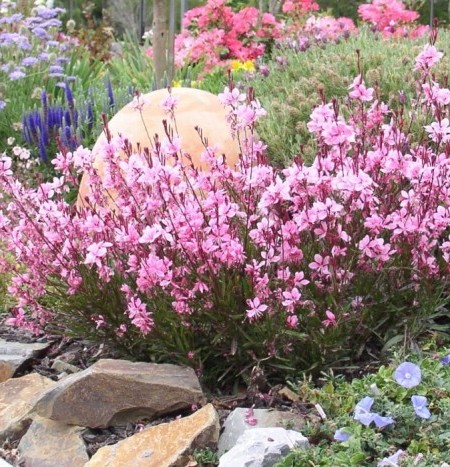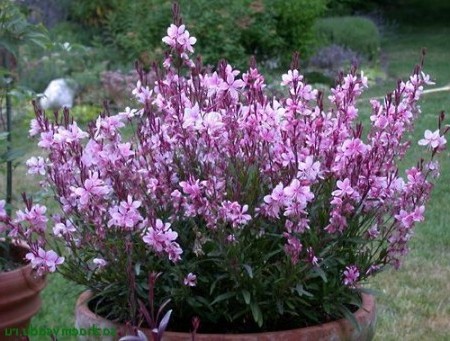Traditionally, the symphony of autumn colors is completed by perennial asters, chrysanthemums, and sedums, which, of course, look great until frost. But how to decorate a cold autumn garden when almost all its inhabitants are preparing for a cold winter? The last chords of the autumn garden can be gaura - an original plant that stands out for its unusual bush shape and arrangement of flowers on it.It requires virtually no care other than moderate watering, but at the same time gives a riot of snow-white or soft pink blooms.
Gaura flower - discreet beauty
The gaura genus includes two dozen species common in North America. It was introduced into culture back in the 19th century, but Russians became acquainted with it only in the 21st. Belongs to the fireweed family. Among its “relatives” we are familiar with indoor fuchsia, natural fireweed and garden evening primrose.
The winter hardiness of gaura (up to -23 degrees) is not high enough for most of our regions: the plant does not always overwinter safely. But this is not a reason to stop growing gaura.
- Firstly, it refers to young flowers, flowers that, even in very favorable winters, live only 2-3 years.
- Secondly, it self-sows, and in the spring you can always find seedlings in a flower garden, transplant them and grow them in the right place. The main thing is not to weed or pull them out. The fact is that seedlings are very inconspicuous at first and can easily be mistaken for weeds.
Gaura has a tap root, and such flowers do not really like transplanting, so replant with a clod of earth. I have had gaura growing in my garden for over ten years.
The gaura flower is a bush with numerous thin, stiff shoots. Dark green leaves are located mainly at the bottom of the bush. The ends of the stems end in narrow spike-shaped inflorescences up to 30 cm long. All parts of the plant are slightly pubescent. The height of the plant, depending on the variety, is 60-120 cm. The stems are reddish, almost without leaves. The buds and opening flowers are pink. Of the ornamental species in gardens, Lindheimer (Gaura lindheimeri) is most often grown.
Bush of fluttering moths
The flower is unique: four delicate petals and staminate filaments with large anthers at the ends make it look like a moth. The subtle aroma attracts bees and butterflies. The inflorescence blooms from bottom to top, so seeds can ripen on the plant, “butterflies of flowers flutter,” and buds turn pink. As they grow, the stems begin to droop, giving the bush a spreading shape, so the gaura takes up a lot of space.
Delicate white or pinkish flowers up to 2.5 cm in diameter tirelessly appear on constantly lengthening stems. When you look at a flowering bush from afar, you get the impression that hundreds of moths are fluttering over it.
This “tactful” plant, without having bright large flowers and beautiful foliage, at the same time evokes a feeling of extraordinary openwork, airiness and elegance, diluting densely planted flower beds. This flower will not be “lost” in the garden even when planted alone.
Blooms in late June - early July. Flowering wanes slightly towards the end of July - beginning of August, but if the stems are cut back by about a third at this time, by September the plant will again turn into a cloud of fluttering moths.
Young plants are not impressive - inconspicuous, with simple small leaves with some spots, looking more like weeds. But when the time comes to bloom, they can amaze you and become one of your favorite plants. When the bush grows to a height of 50-60 cm, it is better to enclose it in a wire ring on a stand, and after a while you will get a kind of “fireworks”.
Growing Gaura
Gaura is light-loving and drought-resistant. It prefers to grow in an open sunny area with sandy loam soil. Blooms weakly in rainy summers.
For the winter, the bushes are pruned and lushly covered with leaf litter.Under other cover, plants may dry out.
Gaura does not tolerate stagnant water, so it needs to be grown in a place where melt water will not accumulate in the spring and during thaws in winter. Once you have grown a beauty, you will understand why experienced flower growers love her.
Gaura is also valued as an arranging plant. Spike-shaped brushes are great in bouquets - all the buds open when cut.
It is easy to propagate gaura by seeds, sowing them in February-March for seedlings or in April - directly into the soil under the film. Blooms in the year of sowing. Seeds are sown for seedlings in moist compost, lightly pressing into the ground, but not falling asleep. Crops are covered with glass or film. Shoots appear in 6-10 days. The seeds are large, oval, with deep grooves, light-colored. When properly stored, germination is maintained for up to 5 years.
Before germination, maintain constant humidity and temperature from +10 to +16 degrees. After the shoots emerge, the glass or film is removed. At the stage of one true leaf, seedlings dive into pots. They are planted in the ground when the threat of frost has passed, the distance between the bushes is 35-45 cm.
Gaura seeds can be found in specialized stores. Grown in pots, it can be sold in garden centers. These flowers are also found on the market from private sellers.
Continuation of the topic:






 (7 ratings, average: 3,86 out of 5)
(7 ratings, average: 3,86 out of 5) CUCUMBERS NEVER GET SICK, I'VE BEEN USING ONLY THIS FOR 40 YEARS! I SHARE A SECRET WITH YOU, CUCUMBERS ARE LIKE THE PICTURE!
CUCUMBERS NEVER GET SICK, I'VE BEEN USING ONLY THIS FOR 40 YEARS! I SHARE A SECRET WITH YOU, CUCUMBERS ARE LIKE THE PICTURE! You can dig a bucket of potatoes from each bush. Do you think these are fairy tales? Watch the video
You can dig a bucket of potatoes from each bush. Do you think these are fairy tales? Watch the video
 How our fellow gardeners work in Korea. There is a lot to learn and just fun to watch.
How our fellow gardeners work in Korea. There is a lot to learn and just fun to watch. Eye trainer. The author claims that with daily viewing, vision is restored. They don't charge money for views.
Eye trainer. The author claims that with daily viewing, vision is restored. They don't charge money for views. A 3-ingredient cake recipe in 30 minutes is better than Napoleon. Simple and very tasty.
A 3-ingredient cake recipe in 30 minutes is better than Napoleon. Simple and very tasty. Therapeutic exercises for cervical osteochondrosis. A complete set of exercises.
Therapeutic exercises for cervical osteochondrosis. A complete set of exercises. Which indoor plants match your zodiac sign?
Which indoor plants match your zodiac sign? What about them? Excursion to German dachas.
What about them? Excursion to German dachas.